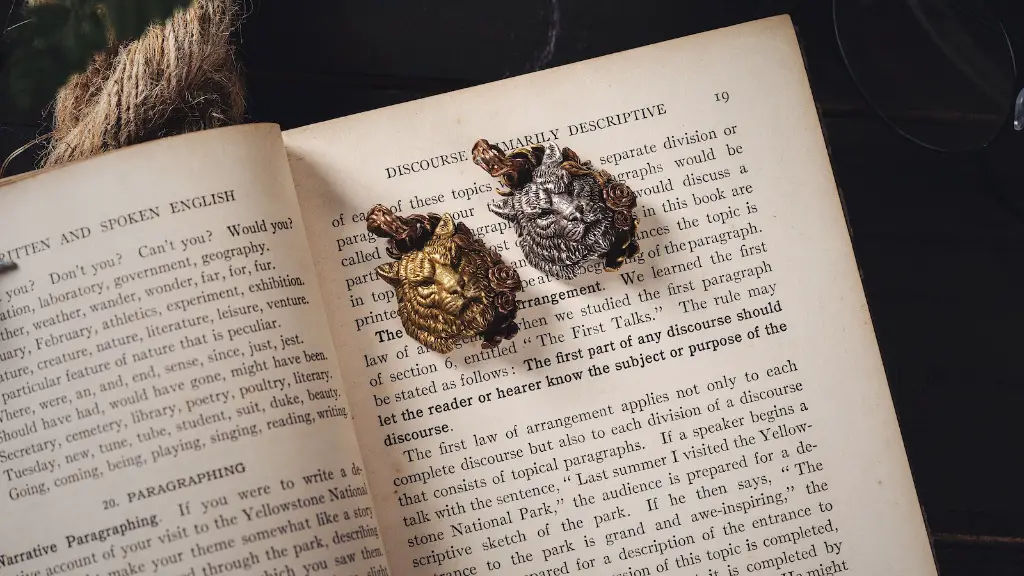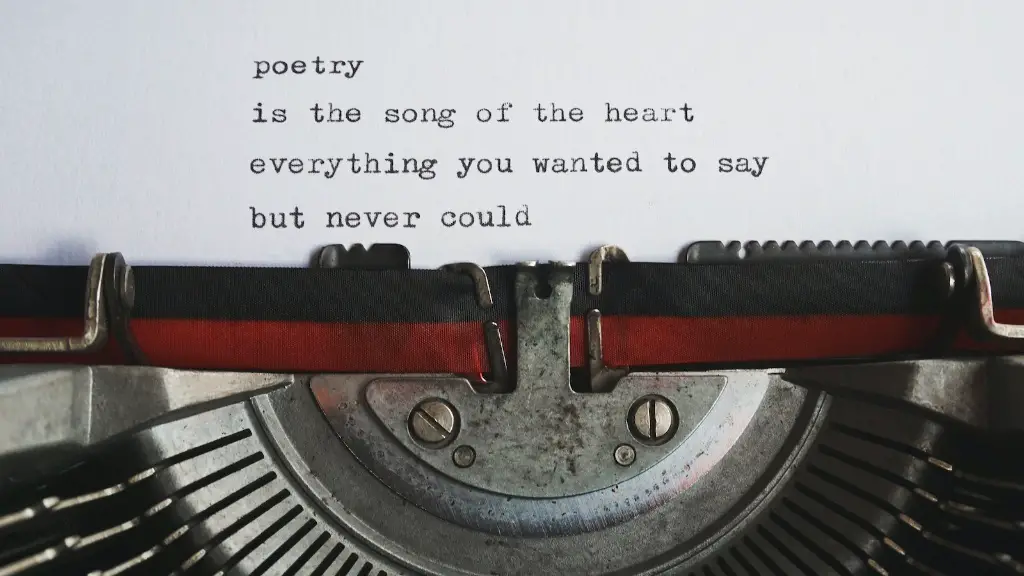Cacophony in poetry is a type of sound device used to create a dischordant, chaotic feeling within the poem. It works by creating a confusing environment that the reader can explore and feel their way through. Cacophony is used in poetry to evoke an atmosphere, add emotion, and create tension in a poetic setting.
Cacophony can be created by combining a range of different sound combinations, effects and vibrations. It can involve the use of alliteration, assonance, onomatopoeia, polysyllabic rhymes, hard consonants and consonant clusters. All these techniques are used to create a harsh, dischordant feeling that is essentially the opposite of euphony.
When using cacophony in poetry, it is important to be aware of how it fits into the overall structure of the poem. Cacophony should be used judiciously, so that it does not detract from the meaning of the poem or take away from its artistry. Too much of it can make the poem unreadable and turn off the reader. It is especially effective when used to emphasize a point that has already been made in the poem.
Experts in the field of poetry and creativity have revealed that the use of cacophony can add complexity and depth to a poem. It can encourage engagement and lead the reader in a certain direction. Cacophony can bring a certain intensity to a poem, and also widen the reader’s perspective when analysing it. It can even be used to highlight the importance of certain words or phrases in the poem.
However, when using cacophony in poetry, it is important to ensure that it is not used too often or too extensively. It can be used sparingly to add emphasis and power to certain words or phrases, but it should never overpower the poem or take away from its meaning. This can be achieved by using advanced phrasal patterns and controlling the sound levels.
Overall, it is clear that cacophony in poetry can add depth and intensity to a poem and can be used effectively to emphasize certain points and evoke an atmosphere. When used judiciously, it can give the poem an extra layer of complexity, encouraging the reader to explore the poem and uncover its true meaning.
How To Effectively Use Cacophony In Poetry
When using cacophony in poetry, it is important to pay attention to the rhythm and sounds used. It is best to start by creating a clear base rhythm and then adding fingers of the different techniques discussed above. This can help create a unified and consistent sound without it becoming overwhelming or dischordant. A good technique is to use assonance, onomatopoeia, and polysyllabic rhymes in tandem to build up a varied sound.
Finger cymbals and other instruments can be employed to create a richer, full sound. These instruments can evoke an intense atmosphere and can bring an element of chaos to the poem. This can be used to great effect in order to draw the reader in and encourage exploration.
It is also important to pay attention to the rhyme schemes used. The use of internal rhymes and half rhymes can be effective in creating a chaotic atmosphere. These can be used to emphasize certain words and phrases and to add an element of surprise.
It is also important to be mindful of how long the poem is, and how many of these chaotic elements are being used. Too many chaotic elements can quickly become overwhelming and detract from the beauty of the poem. As such, it is best to use cacophony sparingly and only to emphasize certain points or evoke a particular atmosphere.
Cacophony As A Symbol Of Chaos
Many poets have used cacophony to signify chaos and disorder. It is often associated with sadness, anger and confusion. It can be used to evoke a feeling of disfunction and turmoil, allowing the reader to explore the depths of a certain emotion.
In some works, cacophony is used to signify the descentinto madness, allowing the reader to feel the anguish and confusion of the protagonist. It can also be used to signify a descent into chaos, as the reader is flooded with a barrage of dischordant sounds.
In this way, cacophony can be used to create a tangible feeling of unease and tension. The chaotic sounds can easily create discomfort for the reader, making them feel as if there is something lurking beneath the surface. It can be used to great effect in creating a sinister atmosphere or situation within the poem.
Conclusion
When employed in a able manner, cacophony can be a powerful tool for the poet. It can be used to add a layer of chaos and disorder within the poem and can allow the reader to explore and feel their way through the work. It can also emphasize and add intensity to certain words and phrases. Cacophony can add depth to a poem and can open it up to interpretation, allowing the reader to uncover its true meaning. For these reasons, cacophony is becoming increasingly popular amongst poets and is viewed as an effective tool for creating emotion and adding an extra level to the poem.
The Role Of Meaning In Cacophony
Cacophony is not only used to evoke emotion and atmosphere, but also meaning. It can be used to draw attention to certain words and phrases within the poem that the poet wishes to emphasize. It can also be used to turn the reader’s attention to the structure of the poem and the rhythm of the words.
The use of cacophony can also make the poem appear aesthetically pleasing, as the reader can explore the chaotic sound combinations and discover the hidden meaning behind them. This can be effective at conveying a deeper message to the reader and drawing their attention to the true meaning of the poem.
Cacophony can also be used to create a sense of tension within the poem. It can bring to the surface powerful emotions like fear, confusion and sadness and can be used to great effect. Cacophony can add intensity to certain elements within the poem, allowing the reader to truly appreciate the full power of the work.
The Benefits Of Cacophony In Poetry
The use of cacophony in poetry can add depth and emotion to a poem, bringing out its full beauty and allowing the reader to explore its hidden layers. It can add a powerful element of chaos and confusion and can lead to the discovery of new emotional dynamics within the poem.
Cacophony is also an effective tool for creating an atmosphere. It can evoke an emotional response from the reader and lead them in a certain direction. It can add an element of suspense and anticipation, exciting the reader and encouraging them to explore the poem in greater depth.
Cacophony can also be used to bridge the gap between the writer and the reader, forcing them to explore the meaning behind the poem in a different way. This can be particularly beneficial for poets who want to convey a deeper message, allowing them to engage the reader in an entirely new manner.
The Use Of Cacophony To Explore The Sublime And The Absurd
The use of cacophony in poetry can be particularly effective at exploring the deepest depths of the human psyche. It can be used to explore the realms of the sublime and the absurd, allowing the reader to explore and reflect on the dark and unexplored parts of their soul.
Cacophony can also encourage the reader to explore the chaotic nature of life, delving into the depths of humanity and discovering the hidden beauty that exists within chaos. It can be used to explore the duality of life, allowing the reader to see both sides of a situation or emotion, and uncovering the true beauty of each.
The use of cacophony in these cases can be particularly effective, as it creates an atmosphere of confusion and disorder which can truly transport the reader to an entirely different world. Cacophony, when used in this way, can encourage the reader to explore these deep and unexplored psychologies, opening an entirely new perspective.
The Role Of Cacophany In Examining Pain And Suffering
The use of cacophony in poetry is also effective in exploring the darker complexities of humanity, such as pain and suffering. It can be used to explore the feelings of loss, sadness and emptiness, evoking an atmosphere of despair and longing.
Cacophony can be used to great effect when examining these powerful emotions, as it allows the reader to explore the depths of pain and suffering. This can be a powerful tool for examining the depths of human emotion, as it allows the reader to gain insight into the true nature of pain and suffering.
It can also be used to reflect on the healing process, as the chaotic nature of cacophony can be an effective tool for exploring the depths of recovery and healing. By exploring the chaotic nature of cacophony, the reader can gain a deeper understanding of the pain and suffering they may be experiencing.
When used carefully, cacophony can be a powerful tool in examining the darker aspects of humanity. It can allow the reader to explore the depths of their soul and gain a deeper understanding of the powerful emotions they may be experiencing.





